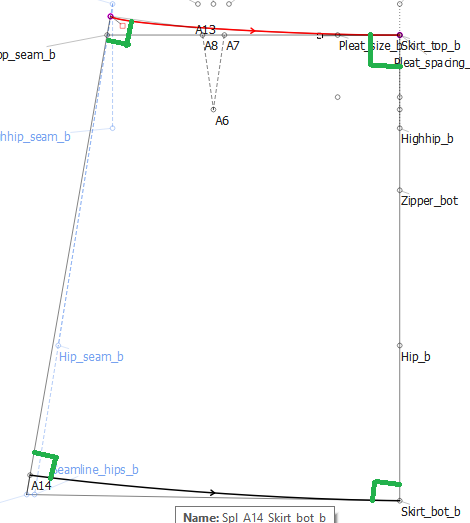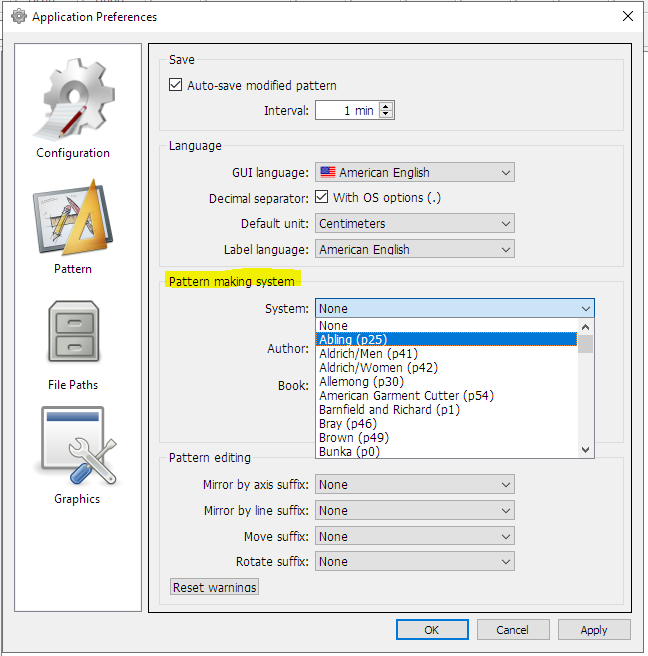I’ve been continuing my work on patternmaking and am moving up the difficulty chain a step or two. I have put together a skirt pattern (which from my reading is kind of the next easiest thing to learn). The pattern is for a basic A-line skirt with pleats. It makes use of the standard measurements from SeamlyMe for the body dimensions as well as a few custom variables for customizing the design automatically.
Regarding naming schemes for the patterns, I am using the _f and _b suffixies for points on the pattern, to keep consistency with how the measurements are named (like waist_arc_f for example). I have also introduced a naming scheme for the custom variables, and this leads me to an idea for a feature request. I have variable names prefixed with ‘style’, ‘fit’, and ‘sew’ for variables that a user of the pattern should adjust and then no prefix (but maybe I should add one like ‘internal’ or something for ones that the pattern uses, but are not meant to be played with unless you are totally redesigning the pattern. Similar to private variables in an object oriented programming paradigm. The ‘style’ variables are for purely stylistic elements like how high up the body does the skirt start and how low below the hips it hangs. The ‘fit’ variables are for adding positive or negative ease, controlling how tight the fit on the body is (which I consider a separate issue from style adjustments). Lastly the ‘sew’ variables are for things relevant to sewing the pattern together, like how much seam allowance to leave on hems or other seams, and other things only relevant during the garment production phase. The unprefixed variables are for things like calculating the number of pleats to apply based on the style choices set, how much extra fabric the pleats will add, and anything else that I use myself in the pattern calculation that a user normally shouldn’t mess with since most (if not all) of these values are formulas and are set automatically once the other measurements are entered.
The idea for the feature request is to add an extra field on the custom variables to set whether they are intended to be adjusted by a user of the pattern or if they are purely for designers working on the fundamental pattern itself. I think it should be more than just a true/false kind of selector, probably a text field with a few standard entries like my ‘style’, ‘fit’, etc outlined above. Interested to hear what others think.
As for the pattern itself, I consider this a draft. I made one skirt purely to check the fit, adjusted the design to add pleats and made a second to ensure the pleat calcs are correct. I want to produce a third, final draft which makes the pleats optional by setting the pleat distance to 0 (and using if statements in Seamly to handle this correctly. I also want to modify the design a bit to make the side seam straighter (or perfectly straight). Currently it uses the waist, highhip, and hip arc_f and arc_b measurements to determine the shape of the side seam. Although this allows the skirt to be much more form fitting, a curved side seam does not play nicely with pleats and looks a bit odd without them. Although the fit is perfect, the aesthetics of the curved seam are a bit off. I would like to know what people here think of the merits of the two options and if a straight seam is better, how to go about constructing on while still approximating the front/back fit as best as possible.
The pleat calculations are done separately for the front and back of the skirt. The user enters variables for the extra fabric to add for each pleat as well as a desired spacing between pleats. Currently the values are set to a desired pleat distance of 2 inches with 1 inch added on each pleat that gets folded in whatever pleat style the sewer is planning on. The calculations the divide the 2 inches into the front and back arcs and round to the nearest whole number to get the number of pleats to use on each segment (for me 5 on each side on front and 4 each side on back). It then recalculates a true pleat distance for front and back and marks spacing guides on each piece with these true values which are very close to, but not necessarily exactly the desired 2 inches in order to ensure a whole number of pleats are put on each segment. I figured it was better to have them be slightly different sizes (in my case less than 1/4 inch difference) than it was to have half a pleat left over along a seam, which would be way more noticeable.
Anyway, here is the pattern file as well as the measurements file used in the design. Obviously if you want to make the design yourself you should swap out the measurements file, but I think it makes sense to include it for ease of testing.
Andrew - 2022-01-02.vit (8.4 KB)
Skirt - A-Line.val (22.0 KB)

